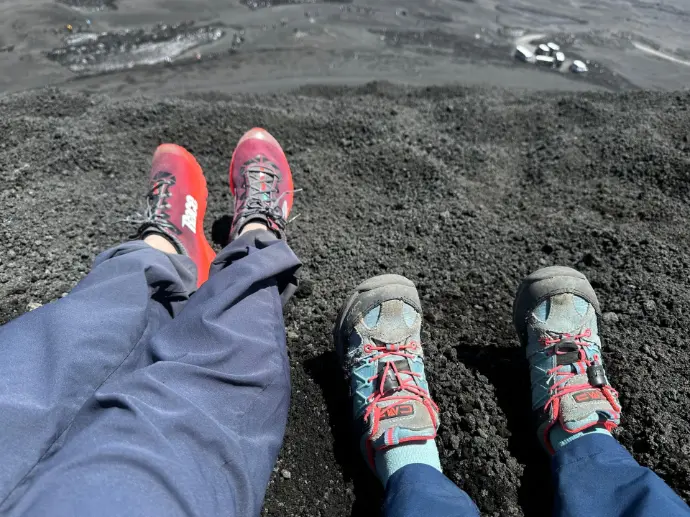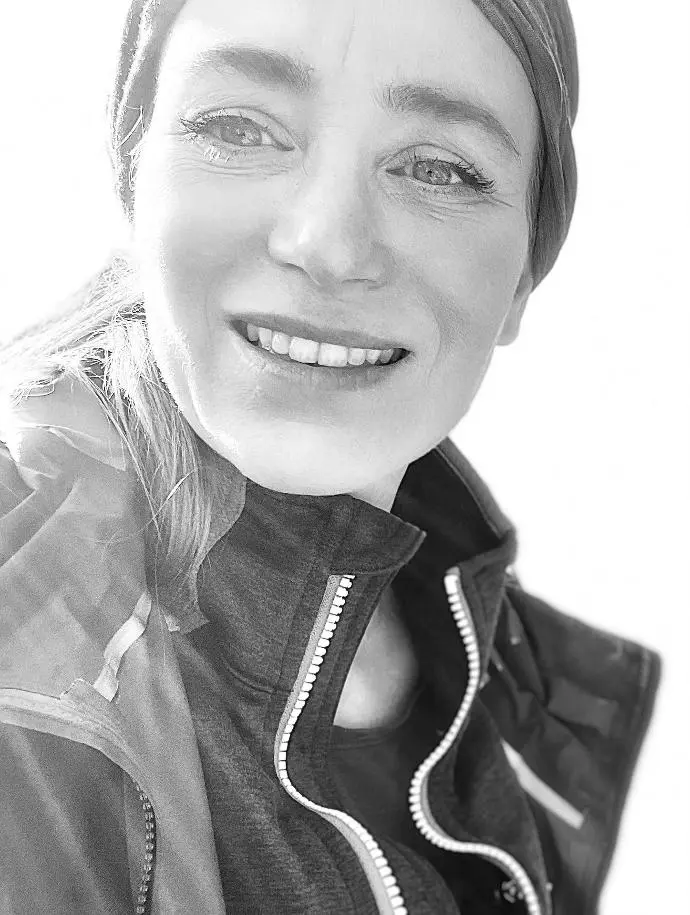We had just reached the top of Mount Etna, and the wind whipping around our feet and legs made the walk seem momentarily impossible. Five minutes into the short hike, it suddenly felt unbearably cold. Our hooded spring parkas and sunglasses were inadequate shields as the sand pummeled our faces, flew in our eyes, and threatened our teeth and tongues if we dared to speak. My five year old, whose dream is to climb and visit Etna, an active volcano, begged to be lifted and carried. Once she was up she quickly buried her face into the crook of her daddy’s neck.
We skirted an old caldera, then another, and finally our guide led us over a ridge, a natural shield from the wind. He suggested we stretch out on the gravel here, and sure enough, as soon as we laid down, we felt the warmth of Etna through our jeans, jackets and shoes. It was like lying on a cozy, moist bed. We were being embraced, by Mamma Etna, as the locals call her. The "hug" brought instant relief from the persistent wind and chill. I asked myself: Why are we as humans so attracted to volcanoes, especially active ones? Perhaps it's for a deep longing for the warmth and moments like these. I came to read later that the locals say Mamma Etna has her mood swings, and she can really "scold" her "children", but they are not afraid, knowing it's just her way of discipline. Perhaps Mamma Etna's bipolar, I think darkly to myself.
Some weeks later I watch a video where my daughter reviews one of her favorite picture books called Bang: the Wild Wonders of Earth's Phenomena, by Jennifer N.R. Smith. My daughter's book review, completely unrehearsed, is not so much about the book itself which is packed with facts, but is about how the ideas and what we know about volcanoes inform her view of the earth and world she lives in. For those educators studying epistemological constructionism, the video she made is a dream artifact. Although she can’t quite recall some key vocabulary, she speaks confidently explaining each related phenomenon: crystals, lava caves, tectonic plates, etc. As her small hands flit about, she points to illustrations. Then, putting the book down, she demonstrates how the earth’s crust kinda floats and that we live on it, whilst the tectonic plates shove, jostle and slide about. What’s most endearing to me is that she explains it all without mentioning the word tectonic. But she goes on to describe most accurately what happened to the people of Pompeii. Their tragedy then mingles a bit with her memory of our own loss and grief.

My youngest daughter’s fascination with volcanoes began eleven months prior with the passing of “Nonno Vincenzo” my three children’s Italian grandfather, and my husband’s dad. Nonno, as we called him, had returned to his home-town in Italy, not far from Vesuvius, to live out the final chapter of a very full and exciting life. At the tender age of 19 he had migrated to America in search of a new beginning and work. When he returned to his village some fifty five years later he was welcomed as a hero, as the excitement for his career as a Soccer Referee who served in several FIFA World Cups spread to neighboring villages. At his eightieth birthday in a restaurant overlooking a valley, several strangers asked him for a selfie.
For my children, who are Italian American but also Swiss, Nonno’s burial was their first experience of a traditional Southern Italian style funeral. For Nonno, the entire Neapolitan village came out to mourn his passing. Laid out on a bed in the living room, he was dressed in his finest suit, his referee whistle placed thoughtfully on the lapel. That morning family, friends and neighbors visited and whispered their farewells through tears and muffled sobs. Later he was transferred to a hearse. Suddenly, the entire village was with us as we walked slowly behind the vehicle, the church bells tolling mournfully as we reached them for the service.
Our visit to Naples for my father-in-law’s funeral was heavy with grief and sadness for his widow, a high-school friend he reconnected with after decades away, and had married just five years prior to falling ill.
On our last day in Naples, seeking something to lift our spirits, we visited the Archaeological Park of Herculaneum. It was a dry, hot day in June. My daughter’s small, damp hand in mine, as we walked slowly through the ancient cobbled streets, sometimes seeking shade where we could find it among the Roman ruins of homes, shops, gyms and bakeries. All of these had been preserved in incredible detail, such that visitors truly sense that horrific moment of complete permanence. It was the end for the inhabitants, but also for a way of life, a culture and a community. When Mt Vesuvius erupted there was little time to escape its triple deadly threat. The volcano oozed lava, and threw heavy rock-laden ash into the air. Then, the eruption also triggered boiling, toxic mud slides that would catch everyone off guard, smothering thousands.
Reflecting on this, I wandered through the archaeological park thinking guiltily that it’s quite a lot for a small child to absorb, especially the day after a weekend of mourning Nonno. I began to question my parenting decision to visit Herculaneum, particularly as we neared the final site, which I had seen once before. I thought about shielding my little one from this site, but then again, I have two teenagers, so hiding anything in plane view is impossible.
“Look!” yells out the fourteen year old. “Skeletons!”
And there they are, all huddled together, holding each other tight, bracing for the final pyroclastic blast and surge of mud as it engulfs them from behind. Seeing them frozen, in their final embrace, feels weirdly familiar.
“Did they almost escape?” asks my small daughter.
“Yes, they were waiting for boats on that narrow dock, with the sea lapping at their feet.” I hear myself say.
“Did some swim away? Was the sea rough? “
“Well, yes, probably, maybe some escaped on boats...” My voice trails off.
I feel a moment of silence is needed, like the moments we had standing over Nonno's grave as he was lowered into the earth. But instead, my four year old has already moved on, and so have the teens.
“Can we have gelato now?” one of them asks. They bound off toward the little carts lined up at the park's exit.
The afternoon left an impression, and we bought interactive books in both English and Italian in the little gift shop. My youngest daughter at four years old, understood the loss of her Nonno, and the tragedy that happened so long ago. Later, I would reflect on how this journey of mourning would intrigue and ignite a passion that would shape her young life. Despite sadness, the week in Naples planted seeds of pure curiosity, which sprouted into strong stems of enthusiasm and fascination for everything volcanic. It’s been twelve months, and volcano-related projects, crafts, books and yes, even travel, are still topping the family agenda as our spirited five year old takes us deeper into this learning adventure.

Katherine M. Schlatter, EdD
is a mother of three and loves talking about learning theory as it relates to pedagogy, curriculum and lesson planning. For May she persuaded the THENCE team to curate books and lessons around Volcano Awareness Month, with three paper crafts and a coloring set offered by artist and paper engineer Nikita Lai Jing Tse. She also saw the opportunity to talk about how volcanic phenomena offer a beautiful analogy to discuss mental health, and so THIS MONTH is offering book reviews and materials that not only center volcanoes but also serious mental health challenges as Mental Health Awareness is honored during the month of May too.
Do you have something to add to this discussion or curated materials? Get in touch via email or use the form below.